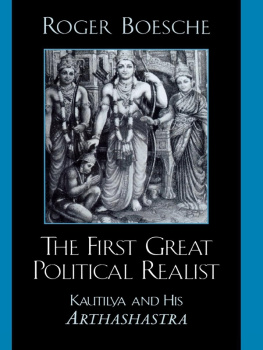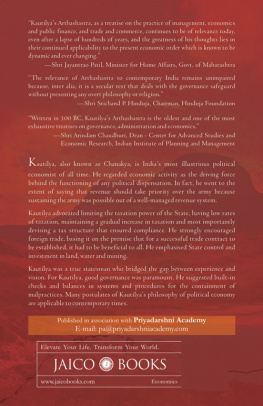Roger Boesche received his Ph.D. in political science from Stanford University, and he has taught the history of political thought at Occidental College in Los Angeles since 1977. He is Professor of Politics and The Arthur G. Coons Professor of the History of Ideas at Occidental. He has published numerous articles and the following books: Alexis de Tocqueville: Selected Letters on Politics and Society (University of California Press, 1985); The Strange Liberalism of Alexis de Tocqueville (Cornell University Press, 1987); and Theories of Tyranny: From Plato to Arendt (Penn State University Press, 1996). He received his second National Endowment for the Humanities Fellowship in order to complete the research and writing of this book on Kautilya. He lives in Los Angeles with his wife Mandy, his daughter Kelsey, and many good friends.
CONCLUSION
In the nineteenth century, French romantic painters journeyed to North Africa, because they could see with their own eyes new colorsin the clothing, in the fruit of the markets, and in the landscapesnot available in Europe. While we may have an idea of the colors of red or blue in our minds, think of the countless variations and shadings of red and blue in the natural and human worlds, a diversity that explodes in more variety as we cross each border. Just as French painters travelled to Algeria to stimulate their imaginations, we read the literature, theology, philosophy, and political thought of cultures beyond the borders of Europe and the United States because they provoke wonder and thought, because they transport us beyond what is customary to us and into realms with new possibilities. We see the world with fresh eyes.
Kautilya is as provocative to one accustomed to European political ideas as any political thinker I know. Some of what he wrote, of course, is unsurprising. A reader understands that Kautilya necessarily wrote political thought constrained by Hindu society including classes, castes, and customs. No thinker in his time or place, not even one as bold and innovative as Kautilya, could imagine ridding India of the four classes or varnas Brahmin priests, Kshatriyas or warriors and rulers, Vaishyas or farmers and merchants, and Shdras or agricultural laborersor the system of inherited occupations, subcastes, or jtis. Even here, however, Kautilya pushed the edges of this caste system by defending the rights of most Shdras to be exempt from slavery and by seeking a popular army that relied on Vaishyas and Shdras. As much as anyone could have done in India at the time, Kautilya defended the status of citizenship for Shdras. Why did he champion the Shdras? Because it was in the self-interest of the ruler to have a peoples army fiercely loyal to him precisely because the people had been treated justly.
Also, the tradition of kingship was deeply imbedded in the Indian tradition and articulated clearly in law books such as the Laws of Manu and the Dharmastras. Indian tradition said that once long ago there was chaosno theory of a Golden Age here, in contrast to early Chinacharacterized by what writers called the law of the fishes or a time when the big and strong devoured the small and weak, quite like Hobbess war of all against all. But then God gave the world kings to bring order. A Hindu state without a king was literally unthinkable, and because a king had earned his power and status through the laws of karma and his actions in previous lives, the populace looked upon a king as superhuman, nearly divine. By using punishment, danda, or the Rod, in just the right measureif the king was too severe, he would be hated, and if he was too lenient, he would lose his authority and chaos would ensuea king brought order and prosperity. Under wise rule, Hindus could pursue the three goals of lifematerial well-being, spiritual goods, and sensual pleasures. The king himself did his duty or dharma, pursued these three goals in life, and lived a life of moderation, avoiding ruinous addictions to women, wine, and gambling.
It is also not suprising to see Kautilya argue that a wise king must take care of his subjects as a father takes care of women and children. Paternalistic in an almost literal sense, Kautilya saw the people of the kingdom not as active citizens but as passive subjects cared for by the king and the state. Arguably the entire notion of a welfare state, in which the state was responsible for those in need either by providing jobs or by supporting those who could not survive without assistance, was first described in the history of political ideas by Kautilya. Moreover, whereas Kautilya did not even entertain the ideas of citizen participation, such as one might find in Greek democracy or the Roman republic, he did describe ways in which a king ascertained the concerns of the populace. By accepting the tradition of the audience hall, one of the most important rooms in the palace at Pataliputra (near modern Patna), Kautilya advised a king to make himself available to anyoneone can be skeptical about how many Shdras or Vaishyas could see the kingwho wanted to present an idea or express a grievance. In addition, one purpose of the all-pervasive spying in Kautilyas kingdom was to gather information, that is, public opinion, including who was disaffected and why, so the king could take action before dissatisfaction boiled over into rebellion.
Kautilyas Arthashastra stands out in Indian philosophy like a Himalaya mountain on an Oklahoma plain, because the chief concern of Hindus was not politics and power but instead moksa or liberation or a union with Brahman that one attains by breaking the cycle of rebirth or samsra. Hindu conquest was a conquest of oneself, so very different from the Greek ideal of glory! As admirable as liberation or moksa might be as a goal in life, it is an apolitical or even antipolitical end, and thus leaves comparatively few people speculating about government or politics, which is one reason Kautilyas Arthashastra is so distinctive. Amidst so many Hindu writers focusing on moksa and dharma or ones duty to the divine, Kautilyas book analyzing the pursuit of political power and economicsliterally, artha or material well-being-is dramatically different, just as is the Kma Sutra or the study of how to maximize sensual pleasure, which is a perfectly legitimate goal in the life of the Hindu householder, one who is in the second stage of life.
Although any book on politics in ancient India would be unusual, Kautilya startles us even further by providing us with a science of wealth and power and politics to conquer, not our inner selves, but instead the political world. More powerful than elephants or chariots or spears, Kautilyas science is a weapon that can teach a king how to conquer the world up to its four ends, or at least to the natural geographical boundaries of India. Armed with this science, a wise king can toy with his enemies.
It seems plausible that Kautilya was confident, even arrogant, because he and Chandragupta had routed the various Nanda kings, stopped the advances of Alexanders successors, and unified India in empire for the first time. While the Arthashastra recounts how that was done, it also advises a king how to proceed with lawful and effective unification, and to accomplish this, Kautilya saw no alternative but a centralized state governing the empire with vast numbers of officials, a bureaucracy looking after the general good, down to the most minute details. In this, Kautilya makes us pause in surprise. Do we want a state this intrusive? Does the state really need to command us to bathe horses twice a day, to wash clothes only on smooth stones, to prescribe penalties for tossing dirt in the road or for harming bushes, and to tell us at what time we must cover our windows at night?













